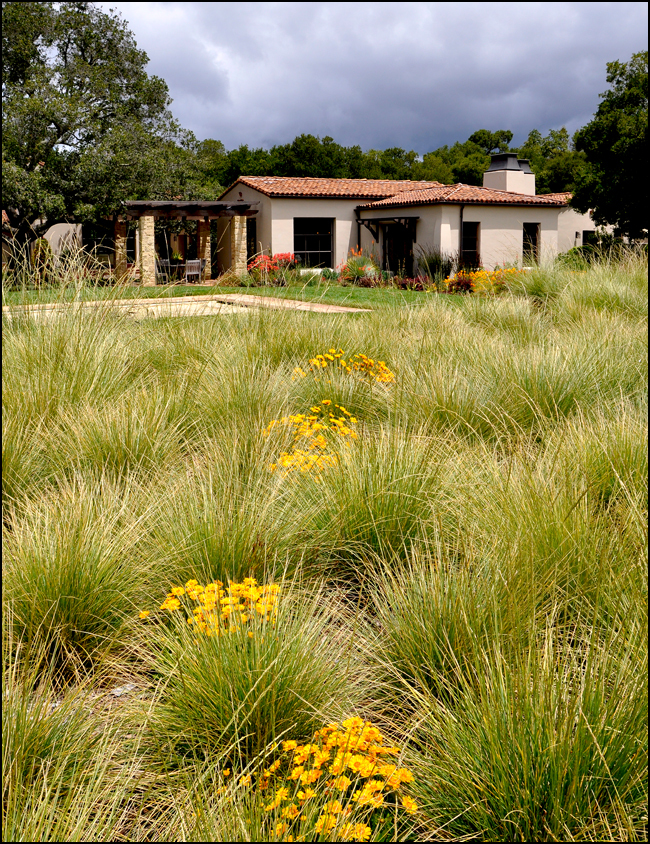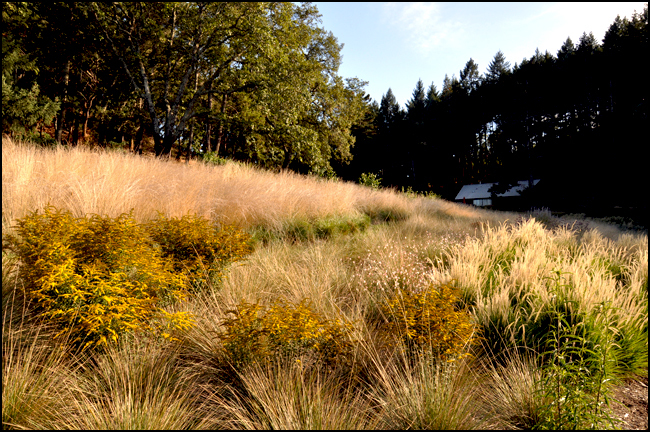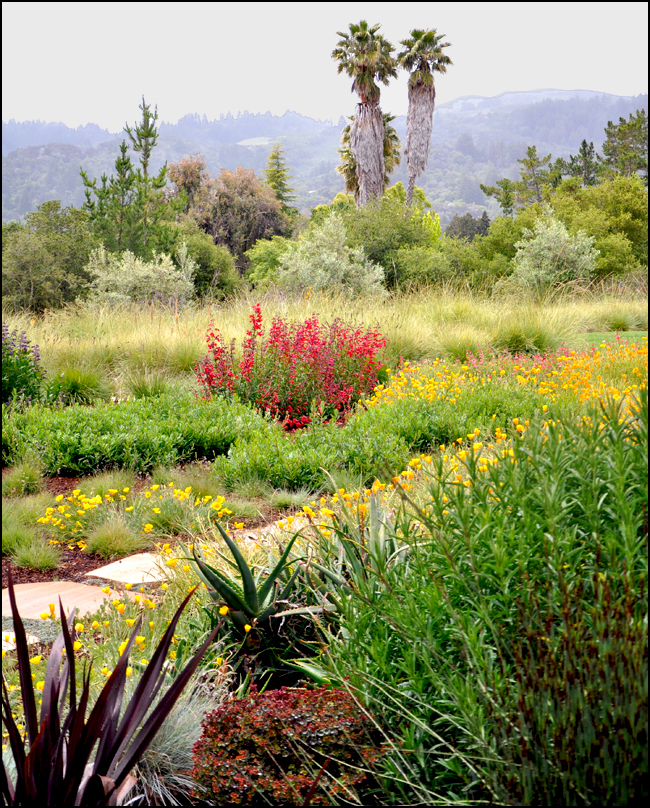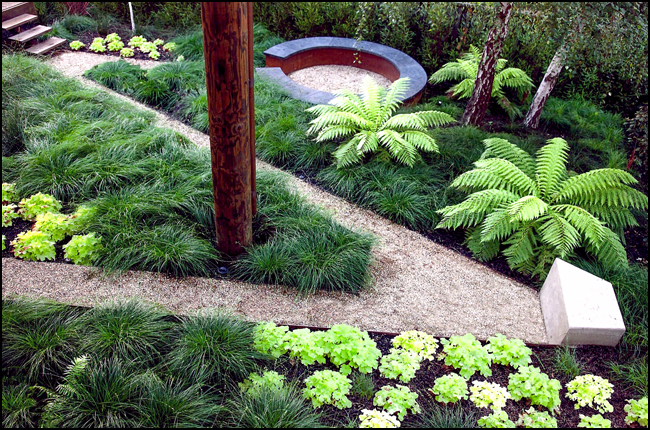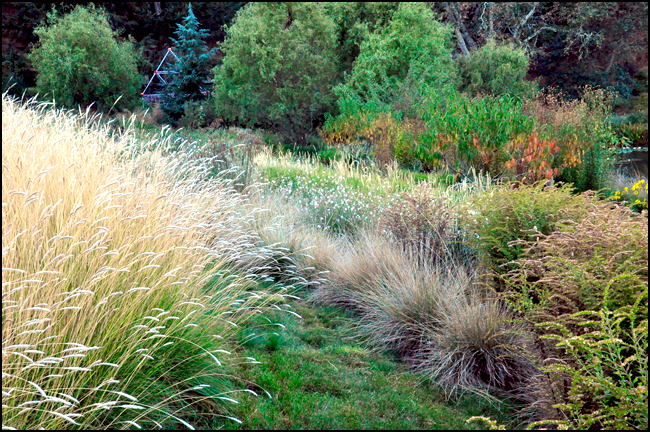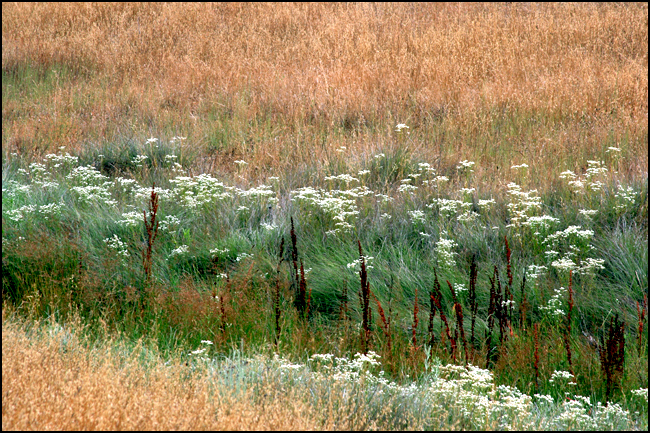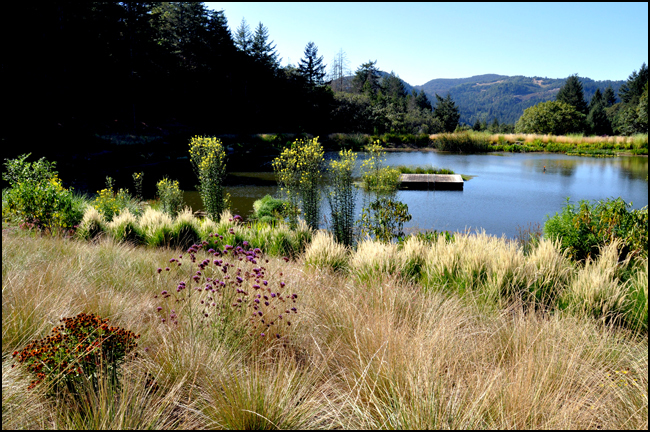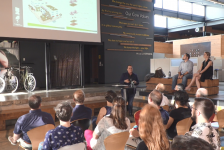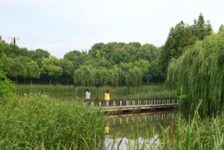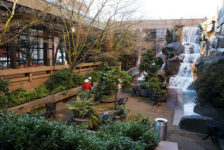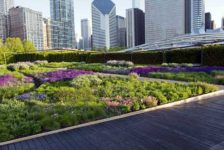Called the “guru of grasses” by Sunset magazine, John Greenlee is an outspoken advocate for the American meadow and the numerous benefits of grassland ecologies. In this interview, John speaks about growing up in suburban Southern California, designing with grasses and sedges, and the ecological wisdom of replacing that conventional lawn with vital habitat. Read on!
“For me, the draw of the meadow has to do with how meadows capture light and movement. No other group of plants can do what grasses and grass ecologies do.“
What makes a meadow a meadow?
While there is actually no real scientific definition of a meadow, it is pretty much a term used to describe grass ecologies that are mostly comprised of cool-season growing grasses. Prairies are generally made up of warm-season growing grasses. Meadows also have a connotation that is more “romantic” or “people friendly” than prairies or savannahs. Many people think of mountain and forest openings as meadows. Most people have positive feelings about “meadows”, that is why I like the term. Meadows tend to be in the range of ankle to just under 3 feet tall.
Can you tell us what you believe to be the draw of meadows on our psyche?
I find it interesting that most true meadow ecologies are where you want to live. Meadow ecologies are usually light-filled openings near trees and water. If it is too wet, it is a swamp; too many trees, it is dark and dank. Most meadow ecology is the sweet spot that is fertile with well-drained soil near trees and water. It is usually the first land to be farmed and inhabited. For me, the draw of the meadow has to do with how meadows capture light and movement. No other group of plants can do what grasses and grass ecologies do.
So many of our favorite blooming plants are found in meadows and I love how grasses work with flowering plants. Take wildflowers blooming in a meadow: how they emerge, put on a show, then take a step back, only to be sequenced by another component as the season progresses. In a real meadow, or well-designed grass ecology, there is a dynamic, ever-changing palette that is way more interesting and alive than any lawn. When I design meadows, I always try to put you in them, not just viewing them from the side.
original image: John Greenlee
So why do we need an alternative to the traditional lawn?
I prefer the term “conventional” lawns to traditional lawns. As a designer, I understand what lawns “do” as a design element. A low, green, uniform panel for the eye to rest, and of course for sports and recreation. But the truth is, the vast majority of mowed lawns are never used for sports or recreation. They are green rugs that have serious environmental consequences when the full effects of water use, chemical use, and air and water pollution are added up. If you want a green, grassy panel, why not plant “alternative” lawns out of native grasses and sedges like Carex praegracilis, Carex pansa, or Poa arachnifera? Once you stop mowing all the time, alternative lawns can actually create habitat instead of destroying it.
When and where did your passion for meadows begin?
As I say in my book, The American Meadow Garden, my love for meadows began as a boy scout, spending summer in the local San Bernardino Mountains. I grew up in suburban Orange County, California in the 1960’s when development was rolling down like a carpet over the landscape. There were no “meadows” where I grew up; I found them in the local mountains.
Also, in The American Meadow Garden you speak of a couple of your childhood experiences involving meadows. For those who have yet to read your book, can you speak more about those experiences?
I was always trying to dream my self out of L.A. where there were not typical seasons and all the rivers and creeks around me where literally paved. We did have an old field on the edge of the orange groves near our house when we were growing up. When you are 5 years old, grass really seams tall. There is something special about just grass and sky. It is powerful.
I distinctly remember coming across meadow lark nests as a child – blue eggs in a nest of grass stems hidden in the grass. That liquid sound of their call is so distinctive that once you know it, you cannot forget it.
original image: John Greenlee
Where do you stand in the “native species vs. introduced species” debate?
This is a great question because the planet is in serious trouble. For me, if a grass or sedge is not native to a particular region, it better be well-behaved. I use a lot of natives in my work but, by restricting plant lists to all natives and mandating only certain species, we are missing the point that you cannot stop evolution, and climate change is bearing down on us like a freight train. A panel of non-native grass, even perhaps a so-called invasive, does far less harm to the environment than a conventional, mowed lawn. At the rate we are destroying the planet, we are going to have to pick and choose our battles.
Some grasses are problematic in some climates and not others. In the south and west, Bermuda grass is the greatest enemy of native grass ecologies but you can buy seed and sod of Bermuda grass at the local, box store. Yet in my area, some fountain grasses are outlawed. Some communities ban the use of Roundup. Now what? You cannot just wish it away. I would need a lot more time to explain myself but there has to be a balance. You cannot just turn the “way back machine” to pre-European settlement and hold it there. Disturbance ecology and some non-native ecologies can still help clean up the environment and create habitat. A lot of native ecology must be burned to stay healthy so what then? We so need balance and compromise in our actions.
There is a wonderful essay by Kathryn Smith titled The Pavilion in the Garden. In this essay, Smith discusses the primacy of landscape and that successful architecture sits in dialogue with its regional landscape. Does this phrase “pavilion in the garden” have a resonance for you and your work?
Well of course it does. California was originally over 1/3 grass ecology, now less than 10% of that is left. I am sure if there were more grasses in the nursery trade when Midcentury Modern was born, there would have been lots of grasses in gardens. Let us face it, many of California’s famous landscape architects were not good plantsman, and their gardens show it as they have not aged well. Ecology is important and bad horticulture makes for shitty design. Fashion is fine, as long as it is ecologically sustainable.
It is interesting that most grasses are a neutral design element. Pair grasses with succulents, it works; pair them with conifers, it is a woodland feel; with roses, a fragrant, romantic meadow. Grasses, well used, can fit into almost any scheme.
original image: John Greenlee
Habitat restoration is a vital element in larger-scale work done with governmental agencies as well as with some private clientele. What role have you played in this area of practice?
Finally we get to the heart of the matter. Lead, follow or get out of the way. Landscape architects, we are not just decorating the planet any more, we have got to think about all the other creatures on this earth. As a plantsman, I am here to help. Let us work together, architects and plantsman, to put habitat into every garden we make.
I will tell you a story. I did a consultation for a large hospital project in California’s Central Valley. They were afraid that if we made “habitat”, if “we built it and they came”, they would not be able to develop the rest of the property. So they went with lawn instead and insisted we not use the word “meadow” in our designs. How screwed up is that? There has to be a balance! The way many of these regulations are written, there is no room for common sense! We have got to change some of those regulations to allow for development and restoration.
Aesthetically speaking, how do you create an appropriate fit for meadows within the geometries of the currently fashionable retro-modernist gardens?
If modernism means you can only use 2 plants, I am not in favor of modernism. I understand the glory of going big with one or two plants but I have got to have seasonality and diversity in my gardens. If you are not adding plants for habitat and pollinators, your “fashion statement” shows a disregard for the serious trouble our planet is facing. This is the reason I like bulbs so much – in many of my meadows, there are maybe 3 species of grass woven together to be a fabric that reads as one. Then there may be over 20 species of bulbs and perennials that at any one given time, only one or two are firing off. So it reads simple but is actually quote horticulturally sophisticated. There is a progression of the accents as the year unfolds.
Are meadows functional at an intimate scale?
Of course meadows work on the small scale. Wolfgang Oehme said most American lawns are “silly lawns” – too small to be used, just plain stupid. In a small garden, a tidy panel of sedges, like Carex pansa in the west or Carex appalachica in the east, are not only better for the environment, they are more beautiful and easier to maintain. If we converted even 10-20% of America’s small lawns to meadows, the ecological benefits in reduced water use and better air quality would be enormous!
Landscape Design: Stefan Thuilot. Landscape Design Consultant: John Greenlee. original image: Stefan Thuilot
Landscape designer, consultant, nurseryman, meadow ecologist, business owner, and guru of grasses: How do you handle these different roles? Are they clearly defined on any given day?
Funny you should ask. Sunset Magazine labeled me a guru and I am still trying to decide if that is a good thing. I think being a nurseryman made me a better designer and being a designer made me a better nurseryman. When I see plants in nature, I am always thinking how it can be used in gardens. I am still always on the lookout for new plants. I am glad, however, that I sold my nursery to Suncrest Nurseries in Watsonville, CA and now I do not have to worry about growing the plants anymore. I was wearing too many hats trying to be a nurseryman as well as a designer. Now I can really focus on my design and consultation work and Suncrest does an excellent job of growing my plants. I do my own design work but much of my time is spent helping other designers create meadows and grass ecologies. My connections, forged from 30 years in the nursery industry, help me source the plants I need for myself and my clients.
I personally really enjoy making meadows. I do much of my meadow design and layout in the field and I tell my clients from the beginning that I prefer to layout the plants on site. That being said, I can put it on paper but that is a lot of work as well. When I am working with other designers, I tell them to get their best colored pencil set out and let us do a color study, and then a volume study, and I can take it from there. If you are a designer, I can help you with as much or as little help as you need. Many of my consultations are only for an hour or two of my time, but it is crucial to the success of the project.
A lot of my consulting work is fixing things that go wrong. It is so much better to do it right the first time. Too much of my consulting work is from failed, hydro-seed mixes; seeding is such a roll of the dice. I prefer planting meadows from plugs, or a combination of seed and plugs. There are so many ways you can go wrong.
The creation of meadows has taken you around the world. What are some of the more interesting locales where you have worked?
The most amazing part of being a “guru” is the strange projects I get drawn into. I loved working with Paul Comstock on Disney’s Animal Kingdom in Florida. I still think it is one of the most amazing gardens in all of North America. If you think kids and dogs are hard to design gardens for, try making a garden for rhinos. Actually much of my zoo work, working for animals, is immensely more satisfying than some of my clients.
I love the gardens I have made in Hawaii and north in Canada…it is exciting to work in different locales. The best part is the network of nurseries that I work with that provide me with local experts. There is no substitute for experienced, local, nursery connections. I am chomping at the bit to do something in Southern Europe because my last visit highlighted that we have more Mediterranean meadow plants here in North America than they do. I spent some time this summer with my hero and fellow plantsman, Piet Oudolf. I was amazed that my nursery associates in California, Suncrest Nurseries, had more native European grasses and sedges than Piet’s local sources. I am going to be sending him native Dutch grasses later this year! I also enjoyed working with James Corner Field Operations on Tongva Park in Santa Monica. This is one of the first of my meadow plantings to be a public park, not just a large private estate. We got to use some of my best, new grasses for California and lots of Mediterranean bulbs that never seem to get into public gardens.
Can you tell us about one or two of your personal favorite “wild meadows?”
I continue to search out native grasses ecologies wherever I go. In Southern California, you must see the Santa Rosa Plateau, a Nature Conservancy managed grassland. I just went to see the grass ecologies in the Eastern Sierra Nevada and was blown away by the saline meadows around Mono Lake. Lucky for me, wherever I go, there is grass. My last “prairie dog” adventure was to the Chiricahuas in southern Arizona. The Chiricahuas are a spine of the Sierra Madre Mountains that come north into the U.S. and are an ecology where desert grassland morphs into oak-pine forest. Edge ecology is always where the action is. Our trophy collections were pinyon ricegrass, Piptochaetium fimbriatum, which I had previously seen only in English collections. We still have so many great native grasses and sedges to bring into the nursery industry so we can put them in our gardens. I will say that I am really excited about the new clones and selections we are making on native western grasses like Leymus triticoides ‘Laguna’ (not yet released) or Bouteloua gracilis ‘Blonde Ambition”. These are standout performers of native grasses that are especially suited to meadow gardening in a Mediterranean setting. Seeing a plant in nature helps you understand how to use them in your work.
Santa Rosa Plateau. original image: Marie Carter
What do you see in the future for meadow ecologies?
The typical American lawn needs to become a thing of the past. Time is up. We need a new paradigm and grasses and sedges are the key. Every parking lot in America, every driveway, every street needs to drain into bio-filters and constructed wetlands. We need green roofs and living walls. We have got to clean up this mess we have made. Grasses and sedges will play an important role in this effort. I can tell you the grasses will be center stage in these movements.
original image: John Greenlee
So, in closing, is there a particular up-coming project or something “on the boards” that you can share with us?
(Laughs) I wish I could tell you. They keep making me sign nondisclosure agreements – it is frustrating but what are you going to do? It is such a small world what we do, does it really need to be a secret? Let us just say I am working on a project that, if they take my advice, will be the most sophisticated, Mediterranean meadow that has ever been made. The majority of the plants are California natives but we can use non-natives (mostly southwestern U.S. natives but some South African plants as well) as long as they “feel” like California. I cannot tell you how excited I am to work on this project because I am getting to work with some giants of landscape architecture who are not afraid to know when to raise their hands and ask a question.
Lead image: John Greenlee at Dwell on Design, June 2013; photo by Mitch Howard
Santa Rosa Plateau image via Marie Carter
Published in Blog


